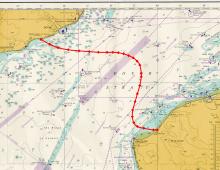The shortest distance in a straight line from England to France is 21 miles. The tides will affect every aspiring English Channel swimmer to varying degrees. A simplistic description of what to expect is laid out in the subsequent paragraphs.
For roughly six hours the tide will take the swimmer 'up' the Channel, and then as the tide changes direction, the following six hours will take the swimmer 'down' the Channel. This up and down movement of the water is relentless and unavoidable.
When traversing the English Channel, the boat pilot pays respect to the aformentioned tides when heading for France, which means the tidal affect will be perpendicular to the direction of the swimmer. It is incredibly rare for a swimmer to ever be swimming with or against the tide.
The moon's position relative to the earth and sun changes, creating different strengths of tide. The smaller tides are called neap tides, and the bigger ones are spring tides. Historically, swimmers have made their attempts on neap tides, as the belief is that this reduces the effect of wind against tide. It also reduces the risk of the swimmer missing the land target of Cap Gris Nez in France.
During the swim season (July - September) you can track crossing attempts on our live tracking page. For completed swims after 24th July 2012 you can generate their swim tracks on our swim routes page.

Sandettie Lightship Observations
2am, 4th December 2025
Water: 53.2 °F (11.8 °C)
Air: 45.7 °F (7.6 °C)
Wind Speed: 20.0 kn (37.0 km/h)
Wind Direction: SSE (160°)









